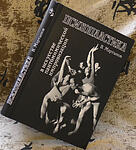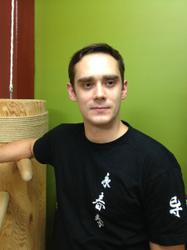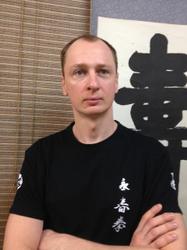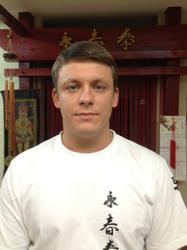Wing Chun Weapons
Wing Chun according to the Master Yuyen Chai Van (Nguyen Te Kong)
 РУКОЯТЬ hilt
РУКОЯТЬ hilt
КРЮК hook-guard
КЛИНОК blade
ОБУХ butt
ОСТРИЕ point
ДУЖКА knuckle bow
ПЕРЕКРЕСТЬЕ cross-guard
ЛЕЗВИЕ cutting edge
The twin broadsword (Bart Cham Dao) is a little known weapon outside the Wing Chun style. Even Wing Chun followers know little about it. William Cheung’s leaflet entitled Butterfly Swords’ is the main available source of information on this weapon. But it comes in a disgraceful translation by the Start’ agency in Chisinau. Now, I would like to dispel some of Master Cheung’s claims regarding the history of twin broadswords. First up is the weapon’s name. Even a good Chinese speaker would have difficulty translating the Chinese term Bart Cham Dao (Cantonese: Bart cham do). Occasionally, the Chinese use the hieroglyph’s image instead of its meaning. Similar examples can be found in English vocabulary, e.g. U-turn’, S-trap’, etc.
Take a look at the first hieroglyph depicted on the left. It resembles a couple of short broad blades, doesn’t it? The meaning of the hieroglyph bat’ (ba) is the number eight’ which misleads many translators. Besides, the character looks a bit different when printed. The second ancient hieroglyph cham’ (chjan), which means to chop’ in modern abridged dictionaries, is currently used only in adverbs and quotations. On consulting advanced comprehensive dictionaries we find another meaning of the character, i.e. to slash’. If you are familiar with the twin broadswords technique you will probably agree that a slash’ is a more appropriate description than a chop’ in this case. Please take my word for it if you are not familiar with them! The final and least complicated of the hieroglyphs is dou’ (dao) and means knife’ or single-blade sword’. My final translation of the whole term Bart Cham Dao is twin broadsword’, though hieroglyph bat’-shaped broadswords’ would be more precise. As for the Russian term Mechi Babochki’, it is a literal translation of the English term butterfly swords’. It is hard to understand why, instead of simply translating the term, local translators have chosen to invent a name. They have ended up causing confusion with the Philippine butterfly knives (or balisongs). Incidentally, in German speaking countries, the weapon is called a doppel Messer’, meaning double knives. Master Cheung claims that the weapon’s name originates from the eight joints impact’ technique. Despite my efforts to unearth references to this technique, I couldn’t find any except for those attributed to the Master himself.
Mr. Cheung then gives his account of the Shaolin Temple’s monks-economists who invented Bart Cham Dao by upgrading large kitchen knives (like those for cutting vegetables). According to Mr. Cheung, the monks carried the knife, hidden from view, in calf-length holsters. I have absolutely no doubt that the Shaolin monks were strong enough to carry a weight of at least 700 to 800 grams on the each calf. What makes me doubtful is that Bart Cham Dao is not mentioned in any of the classical works of the monks Su Fa and Te Quan, The Secret Book of Shaolin Weapons. This contains the most detailed descriptions and images of over 220 weapons used by the Shaolin monks. At the same time, the chuan dao’ or large kitchen knives used for vegetables, are actually mentioned in the book. I have to say that there are numerous supporters of the above story. Some of them even support that fact that there is a noted absence of the twin broadsword in the monks’ list of 220 weapons. They claim twin broadswords were never supposed to be in the list since they were actually secret weapons. I recommend that they re-read the list. They will find that, within it, there are dozens of supposedly rare and sophisticated weapons also believed to have been secret. I consider, therefore, the Shaolin version of the origins of Bart Cham Dao to be the quite untenable.
Let’s leave the popular versions alone for a while (such diverse folklore deserves its own dedicated article) and focus on the weapon’s design features. There is no doubt that the most distinctive feature of the weapon itself is its D-shaped guard, which comes to a hook at the butt end. It is interesting that it has been impossible to find a weapon with a similar design feature either in China or elsewhere in Eastern Asia, from Burma to Japan, certainly not before Portuguese sailors settled down in Macoa harbour in 1553. They branded unique cutlasses. I have to admit, though, I am not sure if those Portuguese who were the first ashore in China had cutlasses featuring D-shaped guards. Hilts such as these became widely used during the 1580’s. By the way, Scott M. Rodell, a Vietnamese weapons researcher, believes the D-shaped guard, which became part of Southern Vietnamese sabers during the early reign of the Nguyen dynasty (1802), indicates a French influence. The cutlass, with its functionality, simple design and, consequently, moderate price became the most popular among sailors. A lack of space along with large amounts of tacking and ropes make the deck of a sailing ship a poor place to maneuver. The use of any kind of long-length weapon is inhibited. Having forced their way past anti-boarding’ defense nets on board an enemy ship, incumbents would have to fight at close quarters with little room for dodging’ attacks. These conditions demanded a maneuverable and functional weapon which would make it possible for the holder to cut, to slash, to thrust, to block opponent’s attacks and to retain grip on his weapon. The cutlass was the perfect weapon to perform every one of these actions (with the notable exception of thrusting). The heavy guard could also be used as a knuckle-duster. The Europeans, who visited old China, describe the Chinese as being people who tended to avoid accepting new things’. It would require repeated convincing and demonstrations of the advantages of a foreign item over a native one to make inhabitants of the Celestial Empire change their minds. It would be easy to imagine such a convincing demonstration in our case. Now, I must disappoint those romanticists who enthuse equally romantic stories! I refer not to extreme cliff-hanger’ fights. More frequent were the phenomenon of pirate attacks on European ships. The Chinese pirates were, to all intents and purposes, impressed by the cutlasses used in action. Being unable to carry the heavy cutlasses which were captured in battles as trophies the Southern Chinese (with their low stature) took the weapon and copied it, right on their own junks (Chinese ships were equipped with forges). The well-known theory that Wing Chun was developed on a junk deck’ might have some credence in relation to the Bart Cham Dao.
The first broadswords made in China had a guard, a cross-guard and a hook-guard manufactured out of a single thick strip of steel, like those on European originals. The hilt of the Chinese weapon resembled a modern racquet handle wrapped in a leather or fabric band, while the broad blade was borrowed from the traditional (in the tropics) large household knife. We can say in another way, the Chinese attached the hilt of the European weapon to local large household knives. The Chinese have upgraded the broadsword by making it an indispensible pair weapon. No one knows for sure whether it was made in accordance with the Chinese traditions or under the influence of Europeans, where it was common to use a cutlass along with a knife or a dagger or, later, a handgun. European handguns at that time featured a brass-bound handle to be used as a club after the shot was made. Anyway, the upgrade made it possible to dramatically increase its efficiency as well as decreasing its weight and size. So the new weapon, which was good in battle, easy-to-use, compact, simple and cheap was developed after 1553, some time between 1580 and 1644. The first emperor of the new Manchurian dynasty of Qing ascended to the throne in 1644, which is believed to have been the year Wing Chun was founded. The twin broadsword became the first weapon of the new style.
Today, it is very hard to find an original specimen of Bart Cham Dao due to a couple of reasons. Firstly, since the weapon was simple and cheap, it wasn’t considered to be valuable enough to be preserved for posterity. Secondly, Bart Cham Dao is infamous for being a popular weapon of pirates and rebels. Have you ever seen a rebel’s bludgeon in any collection of Russian weapons? (By the way, this splendid weapon was left out in the cold for its bad reputation). That is why, nowadays, you are considered lucky to hold or at least see a photo of the old Bart Cham Dao. The well-known Chinese gunsmith, Paul Chen, has recently introduced his own twin broadsword design (see picture 2).

 Mr. Paul Chen is a well-known manufacturer of high-quality replicas, i.e. exact copies, practically indistinguishable from the originals, either in appearance or functional capabilities. Mr. Chen seems to have been unable to find an original example of the twin broadsword to duplicate. For the same reason, to my great chagrin, weapons historians and collectors barely know about the Bart Cham Dao. Wing Chun followers vary in their opinion as to which kind of twin broadsword should be considered the true Wing Chun weapon. In terms of design, the existing examples can be divided into the three types, as follows: the ancient or pre-Wing Chun type (picture 3); the rebel type or the Bart Cham Dao synonymous with the Red Junk Opera’ (picture 4); the new type (the twin broadsword developed by the Wing Chun Master, Leong Ting, shown in picture 5).
Mr. Paul Chen is a well-known manufacturer of high-quality replicas, i.e. exact copies, practically indistinguishable from the originals, either in appearance or functional capabilities. Mr. Chen seems to have been unable to find an original example of the twin broadsword to duplicate. For the same reason, to my great chagrin, weapons historians and collectors barely know about the Bart Cham Dao. Wing Chun followers vary in their opinion as to which kind of twin broadsword should be considered the true Wing Chun weapon. In terms of design, the existing examples can be divided into the three types, as follows: the ancient or pre-Wing Chun type (picture 3); the rebel type or the Bart Cham Dao synonymous with the Red Junk Opera’ (picture 4); the new type (the twin broadsword developed by the Wing Chun Master, Leong Ting, shown in picture 5).
 From my point of view, the design of the weapon changed in conjunction with the development of the Bart Cham Dao fighting technique. The ancient type of broadswords, with their uniformly distributed weight of 700 to 900 grams and constant blade thickness of 2.5mm to 3.5mm, were by far and away the best weapon for cutting and slashing. Its light weight provided a low inertial motion (in case the target was missed) and, consequently, easier transition to a defensive position.
From my point of view, the design of the weapon changed in conjunction with the development of the Bart Cham Dao fighting technique. The ancient type of broadswords, with their uniformly distributed weight of 700 to 900 grams and constant blade thickness of 2.5mm to 3.5mm, were by far and away the best weapon for cutting and slashing. Its light weight provided a low inertial motion (in case the target was missed) and, consequently, easier transition to a defensive position.
 The Chinese kept on searching for ways to perfection and soon the thrust’ motion gained in popularity. Theoretically, the thrust has an overwhelming advantage over the cut. This theory is described excellently in chapter VII of Richard F. Burton’s fundamental work, The Book of the Sword’. The popularity of the thrust is likely to have been caused by the Jiang sword fencing technique. This developmental stage of the Bart Cham Dao technique and design is traditionally attributed to the Red Junk Opera’ and the lead up to the uprising against Manchurian rule. A pair of the rarest broadswords of that time is shown in picture 4. The weapons were definitely manufactured by a real weapons expert. Look at the thickened bronze cross-guard, which is designed to set the centre of gravity off the hilt. An easier-to-use, spindle-shaped Jiang-like hilt takes the place of a flat octagonal one, as found in the ancient type. A prolonged tapered blade with its edge lined up with the hilt made the rebel’ broadsword a perfect thrusting weapon. Theoretically, one simply need thrust one’s weapon towards an enemy’s attacking swing, ready to cut in order to defeat him. Alas, the theory didn’t work. Hopefully the theory isn’t to blame for the defeat of the rebels. Depending on the thrust proved to the wrong technique and, as a result, the rebel-type Bart Cham Dao didn’t last very long. This type of Bart Cham Dao followed the thrusting Jiang sword, which had been completely banished from the Chinese army by the dao’ or saber at the end of the Ming Dynasty.
The Chinese kept on searching for ways to perfection and soon the thrust’ motion gained in popularity. Theoretically, the thrust has an overwhelming advantage over the cut. This theory is described excellently in chapter VII of Richard F. Burton’s fundamental work, The Book of the Sword’. The popularity of the thrust is likely to have been caused by the Jiang sword fencing technique. This developmental stage of the Bart Cham Dao technique and design is traditionally attributed to the Red Junk Opera’ and the lead up to the uprising against Manchurian rule. A pair of the rarest broadswords of that time is shown in picture 4. The weapons were definitely manufactured by a real weapons expert. Look at the thickened bronze cross-guard, which is designed to set the centre of gravity off the hilt. An easier-to-use, spindle-shaped Jiang-like hilt takes the place of a flat octagonal one, as found in the ancient type. A prolonged tapered blade with its edge lined up with the hilt made the rebel’ broadsword a perfect thrusting weapon. Theoretically, one simply need thrust one’s weapon towards an enemy’s attacking swing, ready to cut in order to defeat him. Alas, the theory didn’t work. Hopefully the theory isn’t to blame for the defeat of the rebels. Depending on the thrust proved to the wrong technique and, as a result, the rebel-type Bart Cham Dao didn’t last very long. This type of Bart Cham Dao followed the thrusting Jiang sword, which had been completely banished from the Chinese army by the dao’ or saber at the end of the Ming Dynasty.
In order to develop a better design of twin broadsword it was necessary to learn the drawbacks of the previous Bart Cham Dao. The ancient light-weight broadswords required either great strength or a wild swing, which one can ill afford in close combat. The Bart Cham Dao of the Red Junk Opera’, with their heavy cross-guard and light tapered blade, were suitable for thrusts. However, only in the sense that they were easy to parry by experienced warriors. Those who considered the information above were the highest regarded Wing Chun experts. By saying experts’ I mean those who made a living by their weapons, i.e. headhunters, bodyguards and valuable cargo guards. I’m absolutely convinced that we have them to thank for the development of the new type of twin broadsword. In the early 1990’s, David E. Steel, a well-known American assault weapons expert, carried out research on LAPD forensic medical examination reports with the intention to learn the approximate causes of deaths resulting from the use of assault weapons. Loss of blood was established as the cause of death in the vast majority of the autopsy reports. David’s recommendation to the military was to practice inflicting wide slash wounds, which would cause massive loss of blood. The armed Wing Chun experts came to the same conclusion over a hundred and fifty years before him. They designed the perfect slashing weapon. Having its butt at the cross-guard (as thick as 10mm to 12mm) the blade tails off into two planes, namely, from the butt to the blade and from the cross-guard to the edge. Russian armoires called such a shape double wedge’. Only the most skillful Masters can manufacture a double wedge’ blade. The cost of the weapon corresponds to its complexity. The double wedge’ blade has a very delicate cutting edge, which is easy to damage. Those who favor this blade must correctly comprehend the ancient Taoist philosopher, Shaanxi: A King’s cook, excellent in his skill, began to dress a bull carcass. Every movement of his hand, every bend of his knee and every step of his foot was followed by the sound of skin being detached from bones as well as the sound of his knife. The cook was working at an accurate rate as if performing the Mulberry Grove’ or Ching Show’ dance. “Wonderful!” exclaimed the King, “Your skills are excellent!” Putting his knife down, the cook replied: “My Master, I am more devoted to the way’ than to the skills! My Master, when I began to dress my first bull I could see only its carcass. Three years had passed when I stopped perceiving an animal as a whole thing. Today, I do not look at the bull but comprehend it with my mind. Following natural fibers, I cut joints. I never cut central tendons or ligaments and, especially, thick bones as they are too hard. A good cook tends to cut, so he changes knives once a year. A mediocre cook tends to chop, so he changes knives once a month. My Master, your humble servant has been operating this knife for nineteen years to dress thousands of bull carcasses but its blade looks as sharp as if it had just been whetted on a grindstone. There are gaps between the joints in which to insert a thin blade and let it find its way. Despite that, each time I come across a complicated cut, I see how difficult it is to cope with it; I move the knife very slowly with fear and caution. Suddenly, I finish the dressing very quickly, as if scattering a lump of mud. Then I stand looking around for a while, have a little walk and, satisfied, wipe the knife and put it away.”
“Excellent!” exclaimed the King. Having listened to the cook’s story I realized the secret of a long life.’
Besides the new design of the blade, the Masters of close quarters combat developed a technique of transferring from a front grip to a reverse one (by turning the thumb around). There was only one similar example to this unique grip at the time, i.e. a hold in the Sai Jutsu technique or the technique of fighting with Sai daggers (Okinawa, Japan). Having changed the grip of the weapon quickly, one could either deliver a shattering slash to an opponent from a very short distance or injure him by blocking. The new technique required a new design of weapon. The hilt of the new broadsword was aligned with the butt, the bend of the hook was increased, the cross-guard and hook sections became more rounded. The edge of the hook became longer and sharper which made it possible to grip blade and pole weapons by the hook as well as to use it to attack.
The final version of the weapon with its perfect design has become a true symbol of Wing Chun. Only those who had cognized the philosophy of Wing Chun were able to appreciate all the weapon’s advantages. The common user preferred to stick to blades of the ancient type, upgrading them with heavy bronze hilts for better balance. The first magazine rifles and Mausers appeared in China over three decades. I’m deeply convinced they were the first firearms in China which didn’t allow Bart Cham Dao to take its place among other legendary arms, such as katana, kris, khukri, navaja, yatagan, etc. Nguyen Te Kong, the last Master to use his Bart Cham Dao operating skills to live and win, passed away in 1961.
Today, Bart Cham Dao is not used as a combat weapon, yet its history lives on. There was a period of substantial increase in people’s interest in arms in the US and, later, worldwide in the 1990’s. Original arms became the object of attention for a while. In those conditions twin broadswords could not remain in the shadows, thanks to the popularity of Wing Chun. A big demand resulted in an equally big supply. It is interesting that the number of people teaching the Bart Cham Dao technique currently outnumber those who sell the broadswords. This is because most countries, including Russia, consider the Bart Cham Dao as a weapon, thereby restricting its manufacture and trade. There are only two large manufacturers. They are the abovementioned Paul Chen, Head of the Hanwei Company, and Liang Tin, who established a factory in the city of Foshan, the birthplace of Wing Chun. Different varieties of design of this weapon, manufactured by numerous nameless producers, prompt endless discussions about the true design of the proper Bart Cham Dao. I want to emphasize that there are a lot of intermediate forms besides the three styles already mentioned in the article. You can find a double wedge-shaped’ Bart Cham Dao featuring an octagonal hilt located on the central line between the blade and the butt; a Bart Cham Dao with the ancient type of blade, a narrowly bent hook and a hilt located along the butt; a Bart Cham Dao with a slightly expanding or tapering blade. There is also another group of weapons, which is worth mentioning. The fake broadswords called Hu Die Dao’ or, literally, butterfly swords, have become common products of China over the last two years. The Hu Die Dao can be found in Wushu training weapon sets. The fake broadswords are usually defined as either ancient Shaolin swords’ or genuine Shaolin swords’ by the manufacturers.
As for the Bart Cham Dao training technique, some teachers favor the transfer from a front grip over a reverse one, while other ones refuse to accept it. Broadsword designs vary respectively. The infamous events of September 11, 2001 caused a wave of mass hysteria towards arms in the US. Some of the so-called Wing Chun Masters began to claim that an optimum length of weapon, including the handle, is 12 inches! In order to understand how far these Masters deviated from the truth, one needs to remember that the original length of Bart Cham Dao blade was equal to the distance between the knuckles of a clenched fist and an elbow (about 14.5 inches for a man of an average height). The original length of the Bart Cham Dao handle is equal to one-and-a-half times the width of the fist or about 5.5 inches! I have to say, though, there are true Masters in the US too. As part of his training program called Close Quarters Defense’, Duaine Dieter, a well-known expert in knife fighting and Wing Chun, designed a combat knife called Mark V’ (see picture 6) for the Masters of Defense’ Company.

He also developed a special operating system for the knife, which was based entirely on the Bart Cham Dao technique. The knife has been awarded at numerous prestigious weapon exhibitions and has drawn the attention of experts and the media. I am convinced the Bart Cham Dao technique will be kept in use for a good cause, while combat and self-defense knife designers will keep using its design to develop new products. The whole history of the twin broadswords Bart Cham Dao is a history of search and change. This fact makes me confident.
AFTERWORD
This article is the result of my purposeful gathering and processing the information about everything that is or can be connected with Bart Cham Dao. I have been collecting information on this topic out of curiosity since 1989. A considerable part of the data collected has not been mentioned in this article as the author decided to use only the information confirmed by several sources. Dear readers and internet users, if any of the information I have is confirmed during our communication I promise to share it with you in future articles. Therefore, I am looking forward to receiving Wing Chun admirers’ feedback with anxiety and caution! I would like to know what part of the article makes you indignant or surprised, what questions you have and which part of the article I should have made more detailed or should have excluded. I hope the article hasn’t left you indifferent. If it hasn’t then I shall consider my goal to have been reached.
Sergey Barchevskiy





 Коан – вопрос к членам Федерации Юн Чун Цюань от президента В.В. Мартынова: «Что Вы сделали для Федерации из того, что не мог бы сделать любой другой за деньги?»
Коан – вопрос к членам Федерации Юн Чун Цюань от президента В.В. Мартынова: «Что Вы сделали для Федерации из того, что не мог бы сделать любой другой за деньги?»


